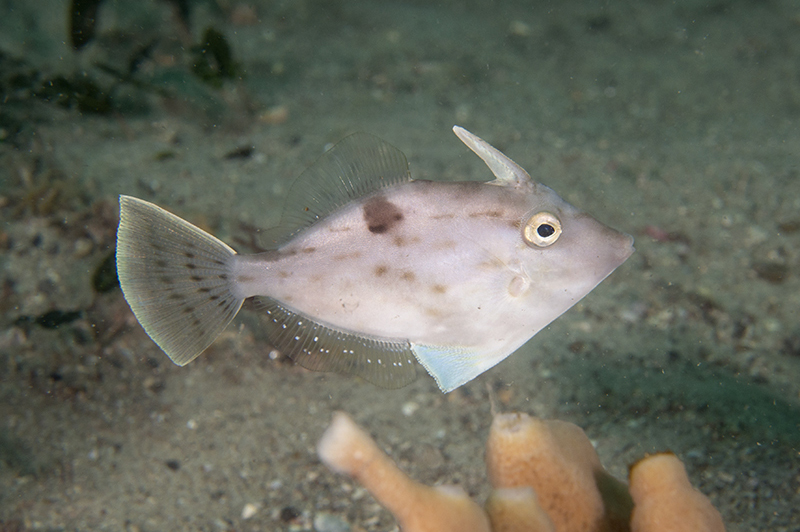Threadfin Leatherjacket, Arotrolepis filicauda (Günther 1880)

A Threadfin Leatherjacket, Arotrolepis filicauda, at Fly Point, Nelson Bay, Port Stephens, New South Wales, March 2017. Source: Dave Harasti / iNaturalist.org. License: CC by Attribution-NonCommercial
A pale brownish to greenish-brown leatherjacket with scattered brown spots and dashes on the body, a prominent dark blotch on the back below the anterior part of the soft dorsal fin, and 2-3 rows of small brown spots across the caudal fin. The upper caudal-fin rays are often produced into a filament - hence the common name "Threadfin Leatherjacket". Juveniles are sometimes carried southwards by the Eastern Australian current, into southern New South Eastern Victoria and Tasmania. They are occasionally found dying at sea or washed ashore in their thousands in southern New South Wales.
Video of a school of Threadfin Leatherjackets being herded into a 'baitball' by Australian fur seals off Montague Island, near Narooma, on the Far South Coast of New South Wales.
The Threadfin Leatherjacket is the only species in the genus Arotrolepis, and was previously known as Paramonacanthus filicauda.
Threadfin Leatherjacket, Arotrolepis filicauda (Günther 1880)
More Info
|
Distribution |
Recorded in Australia from Barrow Island, Western Australia, around the tropical north, with juveniles recorded as far south as Bicheno, Tasmania and eastern Victoria. The species also occurs in Papua New Guinea. Adults usually inhabit shallow waters over sandy or muddy bottoms, usually on coastal trawl grounds in the tropics. Juveniles often form large pelagic schools, and are sometimes carried south by the Eastern Australian Current into Bass Strait. They have been seen dying at sea and at times they wash ashore in their thousands in southern New South Wales and eastern Victoria. |
|
Features |
Dorsal fin II + 32–37; Anal fin 33–37; Caudal fin 12; Pectoral fin 12–14. Body oblong, of moderate depth, with moderate ventral flap; head pointed, dorsal profile of snout convex in male, concave to straight in females and juveniles. |
|
Colour |
Pale brownish, more whitish ventrally, with brownish to yellowish scattered spots high on side; prominent circular blotch usually below anterior portion of 2nd dorsal-fin base; fins clear, sometimes with yellowish and bluish markings; caudal fin with 2–3 oblique lines of dark brown spots across fin, spots more yellowish posteriorly. |
|
Fisheries |
Taken in commercial trawls and considered excellent eating. |
|
Species Citation |
Monacanthus filicauda Günther, 1880, Rept Voy. H.M.S. Challenger 1873–1876, Zoology 1(6): 50, pl. 23(D). Type locality: south of New Guinea. |
|
Author |
Bray, D.J. 2017 |
|
Resources |
Threadfin Leatherjacket, Arotrolepis filicauda (Günther 1880)
References
Allen, G.R. 1997. Marine Fishes of Tropical Australia and South-east Asia. Perth : Western Australian Museum 292 pp. 106 pls. (as Paramonacanthus filicauda)
Allen, G.R. & R. Swainston. 1988. The marine fishes of north-western Australia: a field guide for anglers and divers. Western Australian Museum, Perth. 201 pp. (as Paramonacanthus filicauda)
Blaber, S.J.M., D.T. Brewer & A.N. Harris, 1994. Distribution, biomass and community structure of demersal fishes of the Gulf of Carpentaria, Australia. Aust. J. Mar. Freshwat. Res. 45(3): 375-396. (as Paramonacanthus filicauda)
Gloerfelt-Tarp, T. & Kailola, P.J. 1984. Trawled Fishes of Southern Indonesia and Northwest Australia. Jakarta : Dir. Gen. Fish. (Indonesia), German Tech. Coop., Aust. Dev. Ass. Bur. 406 pp. (as Paramonacanthus filicauda)
Günther, A. 1880. Report on the shore fishes procured during the voyage of H.M.S Challenger, in the years 1872–1876. Report on the Scientific Results of the Voyage of H.M.S. Challenger 1873–1876, Zoology 1(6): 1-82 pls 1-32
Hutchins, J.B. 1977. Descriptions of three new genera and eight new species of monacanthid fishes from Australia. Records of the Western Australian Museum 5(1): 3-58 figs 1-13 (as Paramonacanthus filicauda)
Hutchins, J.B. 1997. Review of the monacanthid fish genus Paramonacanthus, with descriptions of three new species. Records of the Western Australian Museum, Supplement 54: 1-57 figs 1-32 (as Paramonacanthus filicauda)
Hutchins, J.B. 2001. Monacanthidae. pp. 3929-3947 in Carpenter, K.E. & Niem, T.H. (eds). The Living Marine Resources of the Western Central Pacific. FAO Species Identification Guide for Fisheries Purposes. Rome : FAO Vol. 6 pp. 3381-4218.
Hutchins, J.B. 2008. Family Monacanthidae. pp. 822-841 in Gomon. M.F., Bray, D.J. & Kuiter, R.H (eds) Fishes of Australia's Southern Coast. Sydney : Reed New Holland 928 pp.
Johnson, J.W. 2010. Fishes of the Moreton Bay Marine Park and adjacent continental shelf waters, Queensland, Australia. pp. 299-353 in Davie, P.J.F. & Phillips, J.A. Proceedings of the Thirteenth International Marine Biological Workshop, The Marine Fauna and Flora of Moreton Bay. Memoirs of the Queensland Museum 54(3) (as Paramonacanthus filicauda)
Larson, H.K., Williams, R.S. & Hammer, M.P. 2013. An annotated checklist of the fishes of the Northern Territory, Australia. Zootaxa 3696(1): 1-293. (as Paramonacanthus filicauda)
Marshall, T.C. 1964. Fishes of the Great Barrier Reef and Coastal Waters of Queensland. Sydney : Angus & Robertson 566 pp. 136 pls. (as Paramonacanthus filicauda)
Matsuura, K. & Motomura, H. 2016. Arotrolepis filicauda. The IUCN Red List of Threatened Species 2016: e.T79800315A79800492. http://dx.doi.org/10.2305/IUCN.UK.2016-1.RLTS.T79800315A79800492.en. Downloaded on 12 February 2017.
Russell, B.C. & Houston, W. 1989. Offshore fishes of the Arafura Sea. The Beagle, Records of the Museums and Art Galleries of the Northern Territory 6(1): 69-84 (as Paramonacanthus filicauda)
Sainsbury, K.J., Kailola, P.J. & Leyland, G.G. 1985. Continental Shelf Fishes of Northern and North-Western Australia. Canberra : Fisheries Information Service 375 pp. figs & pls. (as Paramonacanthus filicauda)
Swainston, R. 2011. Swainston's Fishes of Australia: The complete illustrated guide. Camberwell, Victoria : Penguin Australia 836 pp.






